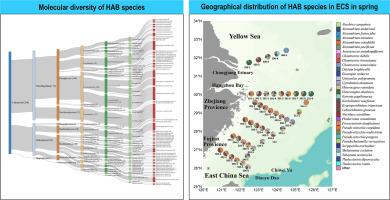Harmful algal bloom species identified in the East China Sea through metabarcoding analysis of large-scale sampling expedition
IF 4.5
1区 生物学
Q1 MARINE & FRESHWATER BIOLOGY
引用次数: 0
Abstract
East China Sea (ECS) is known for its frequent occurrences of harmful algal blooms (HABs) especially in spring, many of which are toxigenic. In this study, we identified HAB species through metabarcoding analysis of 178 water samples collected from 44 sampling sites at different depths in the continental shelf of ECS in spring of 2019. Through amplicon sequence variant (ASV)-based metabarcoding analysis, we identified 3896 ASVs representing 32 classes in six phytoplankton phyla/divisions, among which Dinoflagellata was the most dominant phylum. Among 244 phytoplankton species annotated in this study, 67 HAB species were identified, of which 29 species having the potential to produce toxin. Many of these identified HAB species displayed unique spatial distribution patterns. Phylogenetic network analysis revealed rich molecular diversity of Prorocentrum, Alexandrium and Pseudo-nitzschia genera. Temperature and NO3- both showed significant correlations with most phytoplankton phyla (p < 0.01), while PO43- exhibited significant correlations with the dominant HAB species Chaetoceros tenuissimus (p < 0.05) and Scrippsiella trochoidea (p < 0.01). Clearly, these environmental factors play a key role in influencing the distribution of phytoplankton species in ECS. This study represents the first large-scale attempt in identifying HAB species in ECS in spring through ASV-based metabarcoding analysis. Results from this study will facilitate further comparative research on the molecular diversity and biogeography of HAB species, and monitoring HAB events in ECS.

通过大规模抽样考察的元条形码分析,确定了东海有害藻华的种类
众所周知,中国东海(ECS)以其频繁发生的有害藻华(HABs)而闻名,特别是在春季,其中许多是有毒的。在本研究中,我们通过对2019年春季在ECS大陆架不同深度的44个采样点采集的178份水样进行元条形码分析,确定了有害藻华物种。通过基于扩增子序列变异(amplicon sequence variant, ASV)的元条形码分析,共鉴定出6个浮游植物门/区32纲的3896个ASV,其中鞭毛藻门为最优势门。在本研究注释的244种浮游植物中,鉴定出了67种HAB,其中29种具有产生毒素的潜力。许多已鉴定的赤潮物种表现出独特的空间分布格局。系统发育网络分析显示,原心菌属、亚历山大菌属和伪尼齐菌属具有丰富的分子多样性。温度和NO3-与大多数浮游植物门均呈极显著相关(p < 0.01),而PO43-与优势HAB种细毛毛藻(p < 0.05)和trochoidea Scrippsiella呈极显著相关(p < 0.01)。显然,这些环境因素在影响东中国海浮游植物物种分布中起着关键作用。本研究首次大规模尝试利用基于asv的元条形码分析方法鉴定ECS春季赤潮菌种。本研究结果将为进一步开展有害藻华物种的分子多样性和生物地理学比较研究,以及ECS中有害藻华事件的监测提供依据。
本文章由计算机程序翻译,如有差异,请以英文原文为准。
求助全文
约1分钟内获得全文
求助全文
来源期刊

Harmful Algae
生物-海洋与淡水生物学
CiteScore
12.50
自引率
15.20%
发文量
122
审稿时长
7.5 months
期刊介绍:
This journal provides a forum to promote knowledge of harmful microalgae and macroalgae, including cyanobacteria, as well as monitoring, management and control of these organisms.
 求助内容:
求助内容: 应助结果提醒方式:
应助结果提醒方式:


